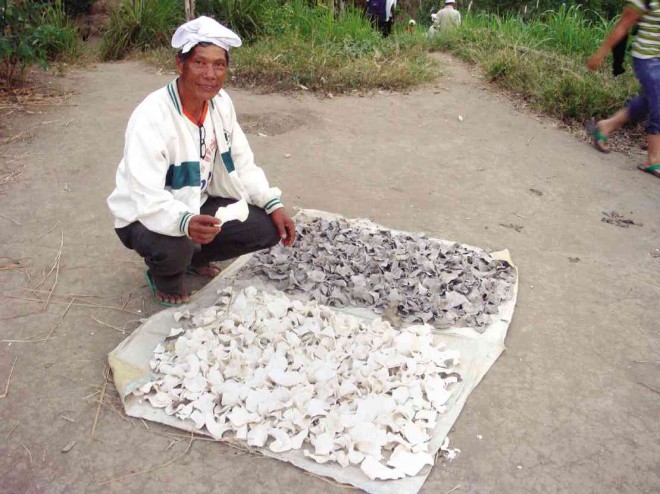
Datu Delfin Mandacayan, an Arumanen Manobo leader in Damulog, Bukidnon province, shows how “kayos” is prepared in this photo taken three years ago. The poisonous yam is an alternative food for many lumad in Mindanao when food becomes scarce. CARLOS AGAMON/INQUIRER MINDANAO
KIDAPAWAN CITY—“Kayos,” or wild yam, could mean life or death for the tribal people of Mindanao, depending on the situation.
These days, the poisonous root crop means life.
As the land in many areas turn into parched tiles of soil, lumad communities are starting to turn to kayos again, a tuber that tribal warriors had used to poison Japanese soldiers during World War II.
The war that tribal communities face now is one on hunger as they watch their crops die, one by one, under a cloudless sky.
Scientifically known as Dioscorea hispida, kayos was used by tribal communities to kill Japanese soldiers during the second world war, according to Melchor Bayawan, a Manobo volunteer for the global nonprofit organization SIL (formerly known as Summer Institute of Linguistics).
While kayos kills, it can also give life, however.
This is now true in many areas of North Cotabato province which are losing their crops (the damage now estimated to be P230 million) to the drought.
“Eating kayos has always been the alternative,” said Bayawan. “It’s not a new type of food for the lumad,” he said.
But kayos as food is not normal because of its poisonous content. Its use as food is a sign of desperate times.
Bayawan said kayos is poisonous if not properly prepared and the process is tedious.
To make it safe to eat, kayos is first peeled and cleansed in running water. The peeled tubers are sliced into thin chips. The chips are squeezed dry, salted and baked under the sun for at least three days.
The city government, however, is not taking any chances following the illness of four residents of the village of Amas who ate kayos.
Provincial officials identified those sickened by kayos as Leonila Sabmawan, Rose Apala, Maricel Sabmawan and Zenaida Apala. “It’s lucky no one died,” said Gov. Emmylou Taliño-Mendoza of North Cotabato. They all felt dizzy after eating kayos, a symptom of poisoning, said the governor.
Mayor Joseph Evangelista, of this city, issued an order to chiefs of the city’s 40 villages, telling them to stop their constituents from eating kayos.
In a text message, Evangelista said he also ordered the city’s social workers to bring aid to communities at risk of starvation because of the drought.
There is no immediate relief in sight from the dry spell as cloud-seeding operations, initially thought to be the most logical solution, appears to be now untenable because there are no clouds in the first place.
Dr. Eliseo Mangliwan, North Cotabato provincial agriculturist, said while his office recommended cloud-seeding, “the problem is there are no seedable clouds.”
In the absence of clouds, Mangliwan said he expects damage to crops to worsen.
Since it started in January, the dry spell had already damaged some P230 million in rice, corn, banana and rubber, crops that are considered the province’s lifeblood.
“Rain is the only remedy,” said Mangliwan.
“The irrigation canals have dried up and the fields are cracking,” a farmer in M’lang town said. Carlo Agamon, Williamor Magbanua, Edwin Fernandez and Julie Alipala, Inquirer Mindanao